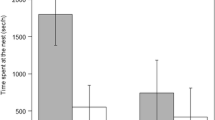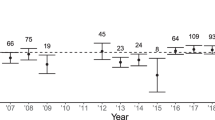Abstract
In cooperatively breeding species, parents should bias offspring sex ratio towards the philopatric sex to obtain new helpers (helper repayment hypothesis). However, philopatric offspring might increase within-group competition for resources (local resource competition hypothesis), diluting the benefits of helper acquisition. Furthermore, benefits of offspring sex bias on parents’ fitness may depend on different costs of production and/or different breeding opportunities of sons and daughters. Because of these counteracting factors, strategies of offspring sex allocation in cooperative species are often difficult to investigate. In carrion crows Corvus corone corone in northern Spain, sons are more philopatric and more helpful at the nest than daughters, which disperse earlier and have higher chances to find a breeding vacancy. Consistent with the helper repayment hypothesis, we found that crows fledged more sons in groups short of subordinate males than in groups with sufficient helper contingent, where daughters were preferred. Crow females also proved able to bias primary sex ratio, allocating offspring sex along the hatching sequence in a way that provided the highest fledging probability to sons in the first breeding attempt and to daughters in the following ones. The higher cost of producing male offspring may explain this pattern, with breeding females shifting to the cheapest sex (female) as a response to the costs generated by previous reproductive attempts. Our results suggest complex adjustments of offspring sex ratio that allowed crows to maximize the value of daughters and sons.



Similar content being viewed by others
References
Allaine D (2004) Sex ratio variation in the cooperatively breeding alpine marmot Marmota marmota. Behav Ecol 15:997–1002
Arnold KE, Griffith AW, Goldizen AW (2001) Sex-biased hatching sequences in the cooperatively breeding Noisy Miner. J Avian Biol 32:219–223
Badyaev A, Hill GE, Beck ML, Dervan AA, Duckworth RA, McGraw KJ, Nolan PM, Whittingham LA (2002) Sex-biased hatching order and adaptive population divergence in a passerine bird. Science 295:316–318
Baglione V, Marcos JM, Canestrari D (2002a) Cooperatively breeding groups of Carrion Crow (Corvus corone corone) in northern Spain. Auk 119:790–799
Baglione V, Marcos JM, Canestrari D, Ekman J (2002b) Direct fitness benefits of group living in a complex cooperative society of carrion crows, Corvus corone corone. Anim Behav 64:887–893
Baglione V, Canestrari D, Marcos JM, Ekman J (2003) Kin selection in cooperative alliances of carrion crows. Science 300:1947–1949
Baglione V, Marcos JM, Canestrari D, Griesser M, Andreotti G, Bardini C, Bogliani G (2005) Does year-round territoriality rather than habitat saturation explain delayed natal dispersal and cooperative breeding in the carrion crow? J Anim Ecol 74:842–851
Baglione V, Canestrari D, Marcos JM, Ekman J (2006) Experimentally increased food resources in the natal territory promote offspring philopatry and helping in cooperatively breeding carrion crows. Proc R Soc Lond B 273:1529–1535
Bednarz JC, Hayden TJ (1991) Skewed brood sex ratio and sex-biased hatching sequence in Harris’s hawks. Am Nat 137:116–132
Bowers EK, Sakaluk SK, Thompson CF (2011) Adaptive sex allocation in relation to hatching synchrony and offspring quality in house wrens. Am N 177:617–629
Caffrey C (2000) Marking crows. North American Bird Bander 26:146–148
Canestrari D, Marcos JM, Baglione V (2004) False feedings at the nests of carrion crows Corvus corone corone. Behav Ecol Sociobiol 55:477–483
Canestrari D, Marcos JM, Baglione V (2005) Effect of parentage and relatedness on the individual contribution to cooperative chick care in carrion crows. Behav Ecol Sociobiol 52:422–428
Canestrari D, Marcos JM, Baglione V (2007) Costs of chick provisioning in cooperatively breeding carrion crows: an experimental study. Anim Behav 73:349–357
Canestrari D, Chiarati E, Marcos JM, Ekman J, Baglione V (2008a) Helpers but not breeders adjust provisioning effort to year-round territory resource availability in carrion crows. Anim Behav 76:943–949
Canestrari D, Marcos JM, Baglione V (2008b) Reproductive success increases with group size in cooperative carrion crows Corvus corone corone. Anim Behav 75:403–416
Canestrari D, Vera R, Chiarati E, Marcos JM, Vila M, Baglione V (2010) False feeding: the trade-off between chick hunger and caregivers needs in cooperative crows. Behav Ecol 21:233–241
Canestrari D, Marcos JM, Baglione V (2011) Helpers at the nest compensate for reduced maternal investment in egg size in carrion crows. J Evol Biol 24:1870–1878
Charnov EL (1982) The theory of sex allocation. Princeton University Press, Princeton
Clark AB (1978) Sex ratio and local resource competition in a prosimian primate. Science 201:163–165
Clutton-Brock TH, Russell AF, Sharpe LL, Young AJ, Balmforth Z, McIlrath GM (2002) Evolution and development of sex differences in cooperative behavior in meerkats. Science 297:253–256
Cockburn A (1990) Sex ratio variation in marsupials. Aust J Zool 37:467–479
Cockburn A (1998) Evolution of helping behavior in cooperatively breeding birds. Annu Rev Ecol Syst 29:141–177
Crawley MJ (2002) Statistical computing: an introduction to data analysis using S-Plus. John Wiley, London
Dickinson JL (2004) Facultative sex ratio adjustment by western bluebird mothers with stay-at-home helpers-at-the-nest. Anim Behav 68:373–380
Doutrelant C, Covas R, Caizergues A, du Plessis M (2004) Unexpected sex ratio adjustment in a colonial cooperative bird: pairs with helpers produce more of the helping sex whereas pairs without helpers do not. Behav Ecol Sociobiol 56:149–154
Dzus EH, Bortolotti GR, Gerrard JM (1996) Does sex-biased hatching order in bald eagles vary with food resources? Ecoscience 3:252–258
Ellegren H, Fridolfsson AK (1997) Male-driven evolution of DNA sequences in birds. Nat Genet 17:182–184
Emlen ST (1991) Evolution of cooperative breeding in birds and mammals. In: Krebs JR, Davies NB (eds) Behavioural Ecology. An evolutionary approach, 3rd edn. Blackwell Science, Oxford, pp 301–335
Emlen ST, Emlen JM, Levin SA (1986) Sex ratio selection in species with helpers-at-the-nest. Am Nat 127:1–8
Ewen JG, Crozier RH, Cassey P, Ward-Smith T, Painter JN, Robertson RJ, Jones DA, Clarke MF (2003) Facultative control of offspring sex in the cooperatively breeding bell miner, Manorina melanophrys. Behav Ecol 14:157–164
Fisher RA (1930) The genetical theory of natural selection. Clarendon Press, Oxford
Gam AE, Mendonça MT, Navara KJ (2011) Acute corticosterone treatment prior to ovulation biases offspring sex ratios towards males in zebra finches Taeniopygia guttata. J Avian Biol 42:253–258
Griffiths R, Double MC, Orr K, Dawson RJG (1998) A DNA test to sex most birds. Mol Ecol 7:1071–1075
Hamilton WD (1967) The extraordinary sex ratio. Science 156:477–488
Heinsohn R, Langmore Naomi E, Cockburn A, Kokko H (2011) Adaptive secondary sex ratio adjustments via sex-specific infanticide in a bird. Curr Biol 21:1744–1747
Howe HF (1976) Egg size, hatching asynchrony, sex, and brood reduction in the Common Grackle. Ecology 57:1195–1207
Kilner R (1998) Primary and secondary sex ratio manipulation by zebra fiches. Anim Behav 56:155–164
Kingma SA, Hall ML, Peters A (2011) No evidence for offspring sex-ratio adjustment to social or environmental conditions in cooperatively breeding purple-crowned fairy-wrens. Behav Ecol Sociobiol 65:1203–1213
Koenig WD, Walters JR (1999) Sex-ratio selection in species with helpers at the nest: the repayment model revisited. Am N 153:124–130
Koenig WD, Walters EL (2012) Brooding, provisioning, and compensatory care in the cooperatively breeding acorn woodpecker. Behav Ecol 23:181–190
Koenig WD, Stanback MT, Haydock J, Kraaijeveld-Smit F (2001) Nestling sex ratio variation in the cooperatively breeding acorn woodpecker (Melanerpes formicivorus). Behav Ecol Sociobiol 49:357–365
Komdeur J (2003) Daughters on request: about helpers and egg sexes in the Seychelles warbler. Proc R Soc Lond B 270:3–11
Komdeur J (2004) Sex ratio manipulation. In: Koenig W, Dickinson J (eds) Ecology and evolution of cooperative breeding in birds. Cambridge University Press, Cambridge, pp 102–116
Komdeur J, Daan S, Tinbergen J, Mateman C (1997) Extreme adaptive modification in sex ratio of the Seychelles warbler’s eggs. Nature 385:522–525
Krebs JR, Davies NB (1978) Behavioural Ecology—an evolutionary approach. Blackwell Science, Oxford
Krebs EA, Green DJ, Double MC, Griffiths R (2002) Laying date and laying sequence influence the sex ratio of crimson rosella broods. Behav Ecol Sociobiol 51:447–454
Legge S, Heinsohn R, Double AC, Griffiths R, Cockburn A (2001) Complex sex allocation in the laughing kookaburra. Behav Ecol 12:524–533
Lessells CM, Avery MI (1987) Sex-ratio selection in species with helpers at the nest: some extensions of the repayment model. Am Nat 129:610–620
Ligon JD, Ligon SH (1990) Female-biased sex ratio at hatching in the green woodhopoe. Auk 107:765–771
Mainwaring MC, Lucy D, Hartley IR (2011) Parentally biased favouritism in relation to offspring sex in zebra finches. Behav Ecol Sociobiol 65:2261–2268
McDonald PG, Ewen JG, Wright J (2010) Brood sex ratio does not affect helper effort in a cooperative bird, despite extreme sex-biased dispersal. Anim Behav 79:243–250
Nam KB, Meade J, Hatchwell BJ (2011a) Brood sex ratio variation in a cooperatively breeding bird. J Evol Biol 24:904–913
Nam KB, Meade J, Hatchwell BJ (2011b) Do parents and helpers adjust their provisioning effort in relation to nestling sex in a cooperatively breeding bird? Anim Behav 82:303–309
Neuhauser M (2004) Tests for a biased sex ration when data are clustered. Environ Ecol Stat 11:295–304
Oddie K (1998) Sex discrimination in birds. Trends Ecol Evol 13:130–131
Pen I, Wessing FJ (2000) Sex ratio optimization with helpers at the nest. Proc R Soc Lond B 267:539–544
Ridley AR, Huyvaert KP (2007) Sex-biased preferential care in the cooperatively breeding Arabian babbler. J Evol Biol 20:1271–1276
Robertson BC, Gemmell NJ (2006) PCR-based sexing in conservation biology: wrong answers from an accurate methodology? Conserv Genet 7:267–271
Sheldon BC (1998) Recent studies of avian sex ratio. Heredity 80:397–402
Stenning AJ (1996) Hatching asynchrony, brood reduction and other rapidly reproducing hypotheses. Trends Ecol Evol 11:242–246
Trivers RL, Willard DE (1973) Natural selection of parental ability to vary sex-ratio of offspring. Science 179:90–92
Varian-Ramos C, Karubian J, Talbott V, Tapia I, Webster M (2010) Offspring sex ratios reflect lack of repayment by auxiliary males in a cooperatively breeding passerine. Behav Ecol Sociobiol 64:967–977
West SA, Sheldon BC (2002) Constraints in the evolution of sex ratio adjustments. Science 295:1685–1688
Woxvold IA, Magrath MJL (2008) Sex-biases in the hatching sequence of cooperatively breeding apostlebirds Struthidea cinerea. Evol Ecol 22:139–151
Xin Y, Xiao Gang S (2009) Linear regression analysis: theory and computing. World Scientific, Singapore
Acknowledgements
We are grateful to two anonymous referees for useful comments on the manuscript and to N. Remón, A. Guerrero and R. García for help in the lab. This work was supported by the Spanish Ministry of Science and Innovation through the project grant CGL2008-01829BOS (to VB), “Juan de la Cierva” program-FSE (to DC) and the Xunta de Galicia (Isidro Parga Pondal program to MV). All bird manipulations were authorized by Junta de Castilla y León.
Ethical standards
Bird manipulations (including measuring, banding, and blood sampling) provoked no permanent damage to adults or chicks (see methods for details), comply with the current laws of the country in which they were performed (Spain) and were authorized by Junta de Castilla y León.
Author information
Authors and Affiliations
Corresponding author
Additional information
Communicated by D. Rubenstein
Rights and permissions
About this article
Cite this article
Canestrari, D., Vila, M., Marcos, J.M. et al. Cooperatively breeding carrion crows adjust offspring sex ratio according to group composition. Behav Ecol Sociobiol 66, 1225–1235 (2012). https://doi.org/10.1007/s00265-012-1375-7
Received:
Revised:
Accepted:
Published:
Issue Date:
DOI: https://doi.org/10.1007/s00265-012-1375-7




